-
Paper Information
- Previous Paper
- Paper Submission
-
Journal Information
- About This Journal
- Editorial Board
- Current Issue
- Archive
- Author Guidelines
- Contact Us
American Journal of Medicine and Medical Sciences
p-ISSN: 2165-901X e-ISSN: 2165-9036
2024; 14(12): 3233-3236
doi:10.5923/j.ajmms.20241412.30
Received: Nov. 17, 2024; Accepted: Dec. 11, 2024; Published: Dec. 16, 2024

Pathomorphological Characteristics of Uterine Mesenchymal Tumors
Umida Arslanovna Kalandarova1, Yuldashev Baxrom Sobirjonovich2
1PhD, Senior Teacher of Urganch Branch of Tashkent Medical Academy, Uzbekistan
2Doctor of Medical Sciences, Associate Professor, Vice-Rector for International Relations of Mamun University, Uzbekistan
Copyright © 2024 The Author(s). Published by Scientific & Academic Publishing.
This work is licensed under the Creative Commons Attribution International License (CC BY).
http://creativecommons.org/licenses/by/4.0/

The materials of 136 patients who were treated with a diagnosis of mesenchymal tumors of the uterus in the Khorezm branch of the Oncology Scientific and Practical Center of the Republic of Uzbekistan were analyzed; the material was analyzed by age and by region. The results showed that the largest number of patients with low-differentiation tumors were observed in patients of the city of Urgench - 24%, and in other areas the frequency is 9%. By age groups, the majority of patients were observed among 50-64-year-olds. The number of observed patients did not depend on the number of people living in the regions.
Keywords: Women, Oncological disease, Tumor, Metastases, Treatment tactics, Polyetiological characteristics, Climatic conditions, Uterine mesenchymal tumors, Regions, Population, Age
Cite this paper: Umida Arslanovna Kalandarova, Yuldashev Baxrom Sobirjonovich, Pathomorphological Characteristics of Uterine Mesenchymal Tumors, American Journal of Medicine and Medical Sciences, Vol. 14 No. 12, 2024, pp. 3233-3236. doi: 10.5923/j.ajmms.20241412.30.
Article Outline
1. Introduction
- One of the most urgent problems of modern medicine is oncological problems that are common among women. Timely detection of oncological diseases is considered the most optimal solution in their treatment, because detection of tumors in the early stages prevents the spread of metastases, and if the treatment tactics are carried out correctly, it ensures the complete treatment of patients. Modern literature contains information confirming that this disease has a polyetiological nature and depends on climatic conditions and the lifestyle of the population in many aspects. A high risk of low-grade tumors, high tendency of metastasization was detected [1,2]. In most patients, low-quality tumors are diagnosed late, because women do not consult a doctor in time. The main complaints are bleeding and pain syndrome.Undoubtedly, one of the causes of this disease is inflammation, hormonal changes [3,4]. From this point of view, the ecologically unfavorable island region is a factor in the development of uterine cancer among the population of Khorezm region, lifestyle and non-observance of personal hygiene rules, and weakening of the immune system due to anemia, because the flora of the uterus It is one of the indisputable facts that change and injury affect the body.Purpose of the scientific work is to study the pathomorphological characteristics of uterine mesenchymal tumors, to develop recommendations for its diagnosis, classification and optimization of the choice of treatment strategy.
2. Materials and Testing Methods
- As material, ambulatory cards, medical histories, results of clinical examinations of patients, as well as results of examination of macropreparations taken during operations and micropreparations prepared from them were obtained at the Khorezm Branch of the Republican Scientific and Practical Center of Oncology in 2010-2023.
3. The Obtained Results and Their Discussion
- In Khorezm region, 136 patients were treated for uterine mesenchymal tumors in the dispensary during 2010-2023. 102 of them are of good quality (75%) and 34 of them are of poor quality (25%). Of these, 8 people (24%) were diagnosed with malignant tumors in Urgench city and district, 9 people (27%) in Khanka district, and 5% in the remaining districts. Of the positive tumors, 34 people (33%) were diagnosed in Urgench city, 29 people (28%) in the district, 12 people (11%) in Khozarasp district, and 11 people (10%) in Kushkupir district.When these are divided into age groups, good-quality tumors are observed in only one case in the age group of 18-44 years, 22 patients (21%), in the age group of 45-59 years, a total of 65 patients are observed (63%), and in this group, the incidence is more observed among women, and in the 60-74 age group, the number of patients was 15 (14%), morbidity slightly decreased. Poor-quality tumors were observed in 5 patients (14%) in the 18-44 age group, 12 patients in the 45-59 age group (36%), and 17 patients in the 60-74 age group (50%) ) organized, table 1.
|
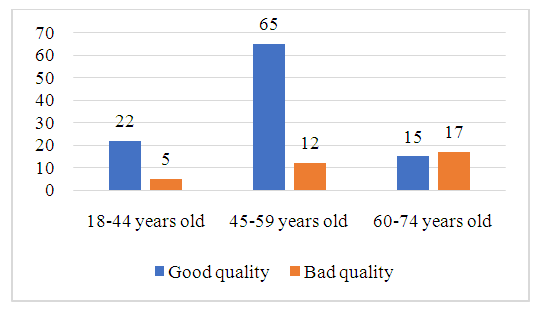 | Figure 1. Diagram of the distribution of tumor types by age group |
|
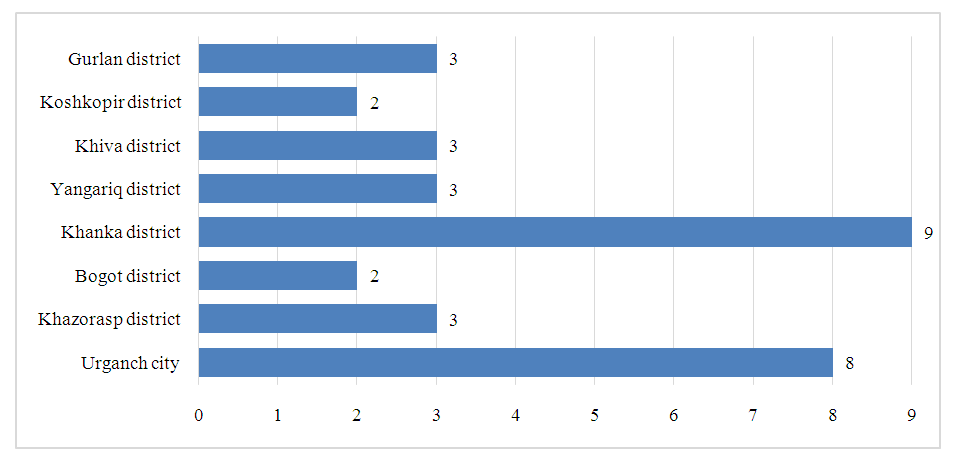 | Figure 2. Diagrammatic analysis of the occurrence of mesenchymal tumors in the regions of Khorezm region |
|
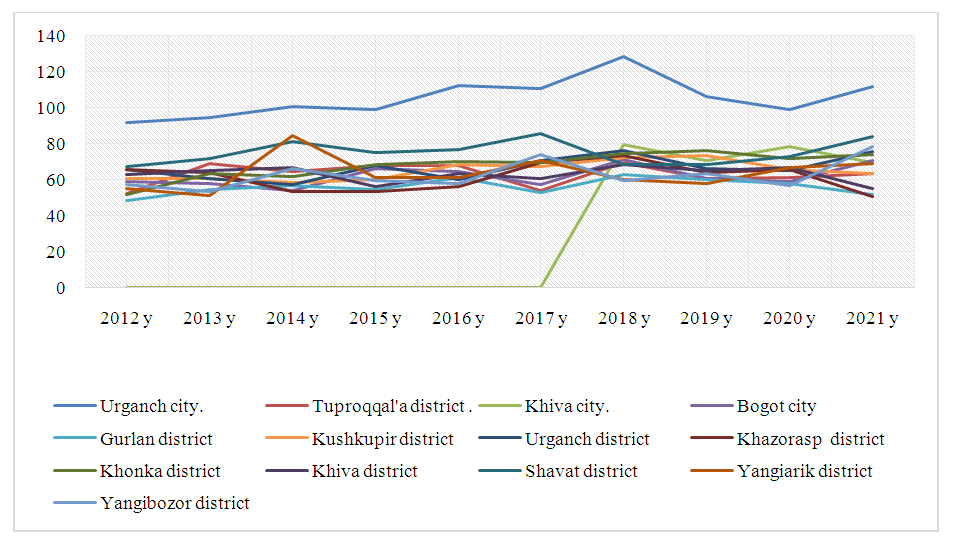 | Figure 3. The general incidence rate is per 100,000 population |
|
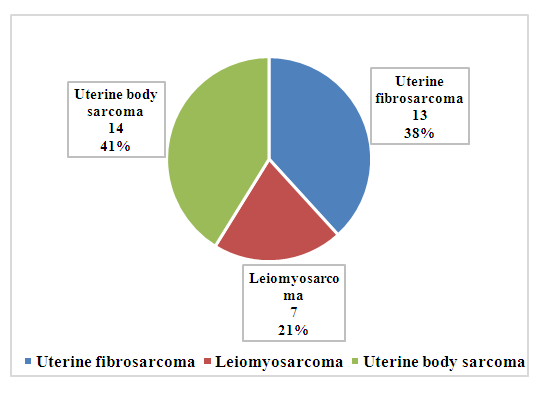 | Figure 4. Types of uterine mesenchymal tumors in the diagram |
|
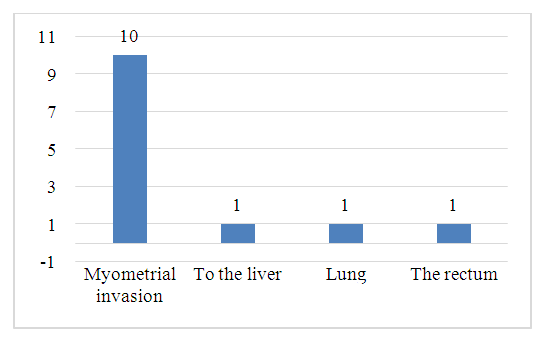 | Figure 5. Metastasis rates of Bad - quality tumors on a diagram |
4. Conclusions
- It can be said that uterine mesenchymal tumors are not only related to the population size in the region, but also to factors such as the customs of the population, the environment (carcinogenesis effect), personal hygiene of patients and hormonal changes, as well as the harmful waste emitted into the environment by industrial enterprises in the regions, which also have significant social significance. In uterine fibrosarcomas, invasion of the myometrium is more common, sarcomas develop more often from histological forms of the disease, if the disease is not detected in a timely manner, metastases occur in a short time and the complications associated with them develop, which lead to a worsening of the patients' lifestyle, prolongation of the treatment process of patients, shortening of life expectancy, and acceleration of mortality.
 Abstract
Abstract Reference
Reference Full-Text PDF
Full-Text PDF Full-text HTML
Full-text HTML



